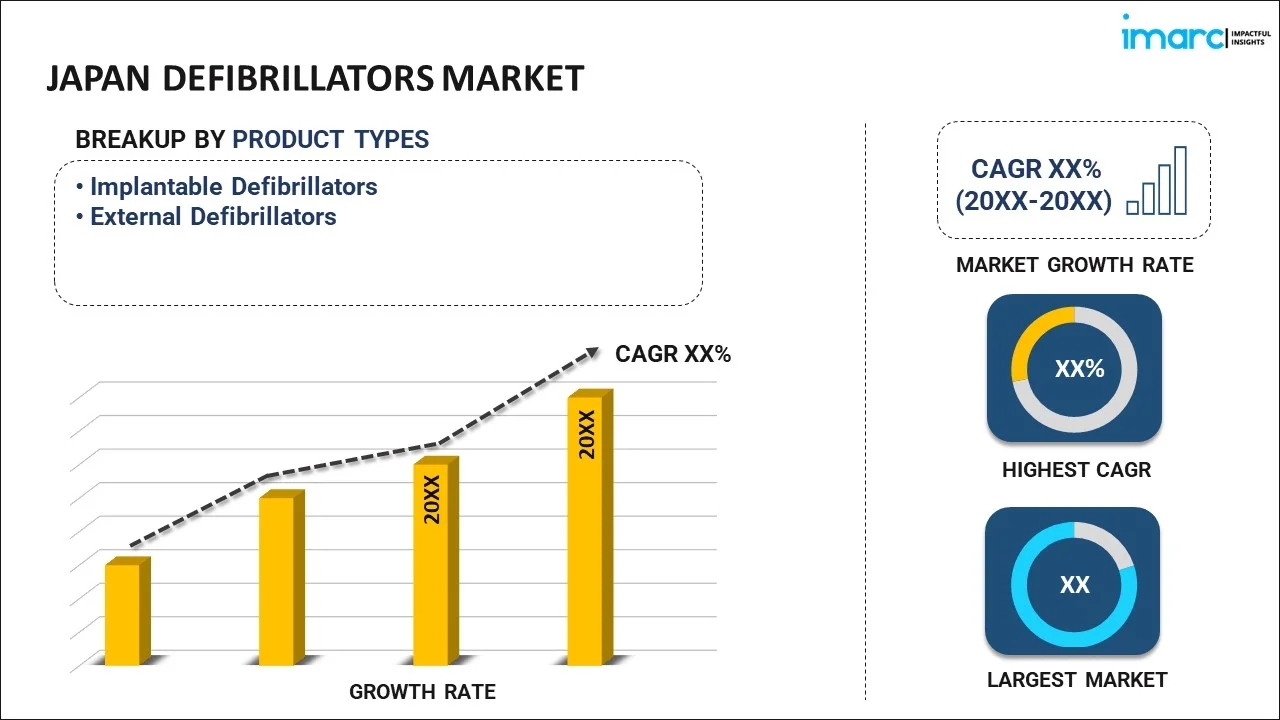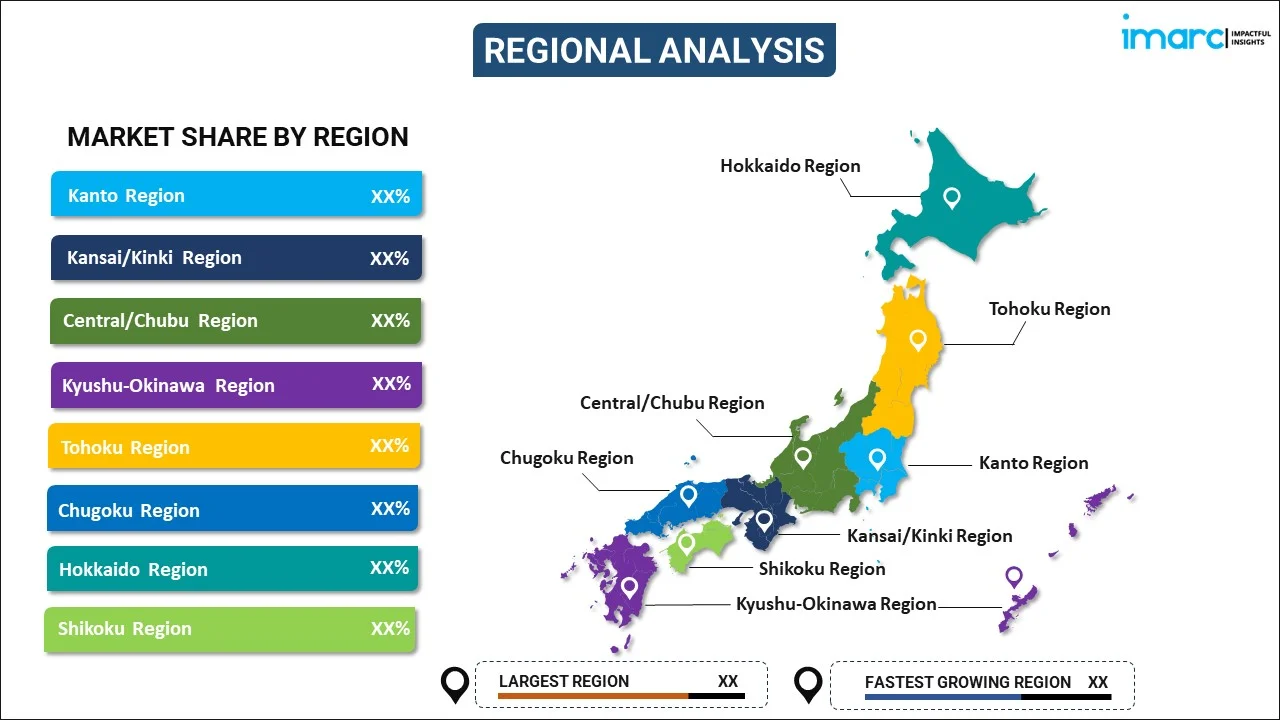
Japan Defibrillators Market Report by Product Type (Implantable Defibrillators, External Defibrillators), End User (Hospitals and Clinics, Prehospital Care Settings, Cardiac Centers, Homecare Settings, and Others), and Region 2025-2033
Market Overview:
Japan defibrillators market size reached USD 290.7 Million in 2024. Looking forward, IMARC Group expects the market to reach USD 539.0 Million by 2033, exhibiting a growth rate (CAGR) of 6.4% during 2025-2033. The market is being driven by several significant factors, including the rising prevalence of heart-related conditions like coronary artery disease and arrhythmias, an increasing number of public access locations, and the expansion of ambulance services.
|
Report Attribute
|
Key Statistics
|
|---|---|
|
Base Year
|
2024
|
|
Forecast Years
|
2025-2033
|
|
Historical Years
|
2019-2024
|
|
Market Size in 2024
|
USD 290.7 Million |
|
Market Forecast in 2033
|
USD 539.0 Million |
| Market Growth Rate 2025-2033 | 6.4% |
Defibrillators are medical instruments engineered to reinstate a regular heart rhythm by administering an electrical impulse to the heart. They are meticulously designed to be accessible and user-friendly, allowing individuals without medical expertise to operate them effectively during critical situations. Their significance becomes evident in emergencies characterized by cardiac arrest, where the heart ceases to function effectively. In such circumstances, defibrillators play a pivotal role by delivering an electric shock capable of restoring a normal cardiac rhythm, potentially saving lives. These devices are typically deployed in medical facilities, ambulance services, and public venues such as airports and shopping centers.
Japan Defibrillators Market Trends:
The defibrillators market in Japan is witnessing notable growth driven by several key factors. Firstly, Japan, like many developed nations, is grappling with an aging population, which elevates the risk of cardiac-related incidents. Consequently, there is a growing emphasis on improving the availability and accessibility of defibrillators in various settings, including public spaces, healthcare facilities, and transportation hubs. Secondly, increasing awareness about the importance of early defibrillation in cases of sudden cardiac arrest is spurring demand. Public access defibrillators (PADs) are becoming more prevalent in Japan, and there is a concerted effort to educate the public about their usage. These efforts contribute to quicker response times during emergencies, potentially saving lives. Furthermore, the Japanese government has been actively involved in promoting the deployment of defibrillators. Initiatives to equip public locations, such as airports, train stations, and shopping malls, with automated external defibrillators (AEDs) have been undertaken to enhance overall preparedness for cardiac emergencies. Hospitals and medical facilities have increased their adoption of defibrillation equipment to respond to potential cardiac complications associated with the virus. Overall, the Japan defibrillators market is poised for continued growth, driven by a combination of demographic factors, public awareness campaigns, and government initiatives to ensure the availability of these life-saving devices.
Japan Defibrillators Market Segmentation:
IMARC Group provides an analysis of the key trends in each segment of the market, along with forecasts at the country level for 2025-2033. Our report has categorized the market based on product type and end user.
Product Type Insights:

- Implantable Defibrillators
- Transvenous Implantable Cardioverter Defibrillator (T-ICDs)
- Subcutaneous Implantable Cardioverter Defibrillator (S-ICDs)
- Cardiac Resynchronization Therapy- Defibrillator (CRT-D)
- External Defibrillators
- Manual External Defibrillator
- Automated External Defibrillator (AEDs)
- Wearable Cardioverter Defibrillator (WCDs)
The report has provided a detailed breakup and analysis of the market based on the product type. This includes implantable defibrillators (transvenous implantable cardioverter defibrillator (T-ICDs), subcutaneous implantable cardioverter defibrillator (S-ICDs), and cardiac resynchronization therapy- defibrillator (CRT-D)), and external defibrillators (manual external defibrillator, automated external defibrillator (AEDs), and wearable cardioverter defibrillator (WCDs).
End User Insights:
- Hospitals and Clinics
- Prehospital Care Settings
- Cardiac Centers
- Homecare Settings
- Others
A detailed breakup and analysis of the market based on the end user have also been provided in the report. This includes hospitals and clinics, prehospital care settings, cardiac centers, homecare settings, and others.
Regional Insights:

- Kanto Region
- Kansai/Kinki Region
- Central/ Chubu Region
- Kyushu-Okinawa Region
- Tohoku Region
- Chugoku Region
- Hokkaido Region
- Shikoku Region
The report has also provided a comprehensive analysis of all the major regional markets, which include Kanto Region, Kansai/Kinki Region, Central/ Chubu Region, Kyushu-Okinawa Region, Tohoku Region, Chugoku Region, Hokkaido Region, and Shikoku Region.
Competitive Landscape:
The market research report has also provided a comprehensive analysis of the competitive landscape in the market. Competitive analysis such as market structure, key player positioning, top winning strategies, competitive dashboard, and company evaluation quadrant has been covered in the report. Also, detailed profiles of all major companies have been provided.
Japan Defibrillators Market Report Coverage:
| Report Features | Details |
|---|---|
| Base Year of the Analysis | 2024 |
| Historical Period | 2019-2024 |
| Forecast Period | 2025-2033 |
| Units | Million USD |
| Scope of the Report | Exploration of Historical and Forecast Trends, Industry Catalysts and Challenges, Segment-Wise Historical and Predictive Market Assessment:
|
| Product Types Covered |
|
| End Users Covered | Hospitals and Clinics, Prehospital Care Settings, Cardiac Centers, Homecare Settings, Others |
| Regions Covered | Kanto Region, Kansai/Kinki Region, Central/ Chubu Region, Kyushu-Okinawa Region, Tohoku Region, Chugoku Region, Hokkaido Region, Shikoku Region |
| Customization Scope | 10% Free Customization |
| Post-Sale Analyst Support | 10-12 Weeks |
| Delivery Format | PDF and Excel through Email (We can also provide the editable version of the report in PPT/Word format on special request) |
Key Questions Answered in This Report:
- How has the Japan defibrillators market performed so far and how will it perform in the coming years?
- What has been the impact of COVID-19 on the Japan defibrillators market?
- What is the breakup of the Japan defibrillators market on the basis of product type?
- What is the breakup of the Japan defibrillators market on the basis of end user?
- What are the various stages in the value chain of the Japan defibrillators market?
- What are the key driving factors and challenges in the Japan defibrillators?
- What is the structure of the Japan defibrillators market and who are the key players?
- What is the degree of competition in the Japan defibrillators market?
Key Benefits for Stakeholders:
- IMARC’s industry report offers a comprehensive quantitative analysis of various market segments, historical and current market trends, market forecasts, and dynamics of the Japan defibrillators market from 2019-2033.
- The research report provides the latest information on the market drivers, challenges, and opportunities in the Japan defibrillators market.
- Porter's five forces analysis assist stakeholders in assessing the impact of new entrants, competitive rivalry, supplier power, buyer power, and the threat of substitution. It helps stakeholders to analyze the level of competition within the Japan defibrillators industry and its attractiveness.
- Competitive landscape allows stakeholders to understand their competitive environment and provides an insight into the current positions of key players in the market.
Need more help?
- Speak to our experienced analysts for insights on the current market scenarios.
- Include additional segments and countries to customize the report as per your requirement.
- Gain an unparalleled competitive advantage in your domain by understanding how to utilize the report and positively impacting your operations and revenue.
- For further assistance, please connect with our analysts.
 Inquire Before Buying
Inquire Before Buying
 Speak to an Analyst
Speak to an Analyst
 Request Brochure
Request Brochure
 Request Customization
Request Customization




.webp)




.webp)












